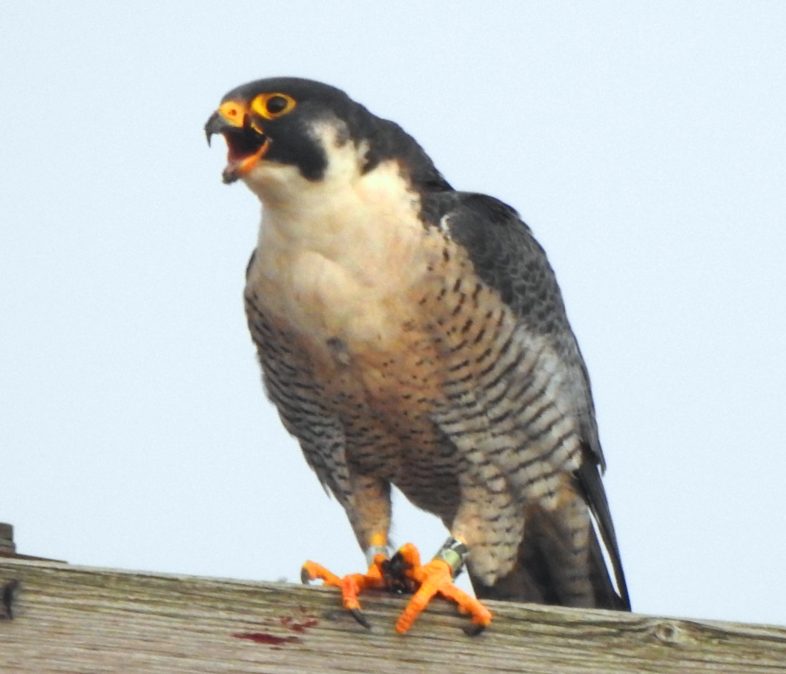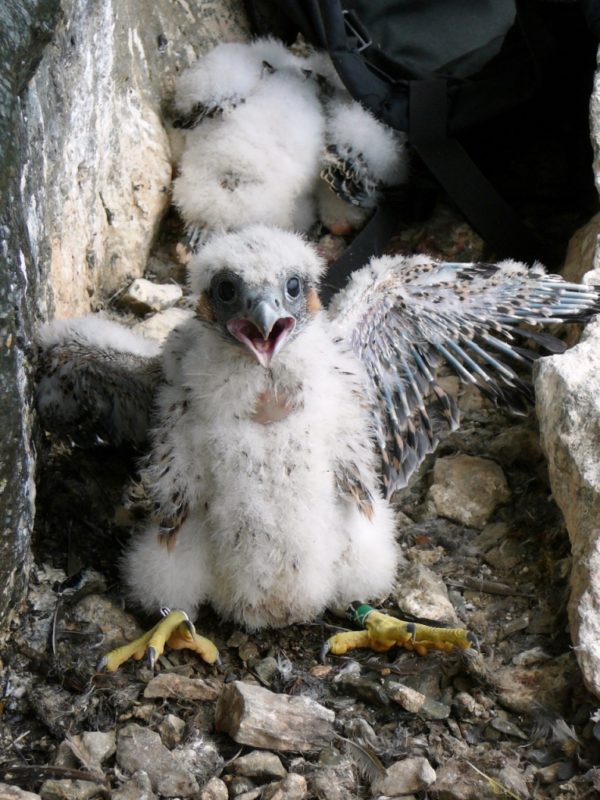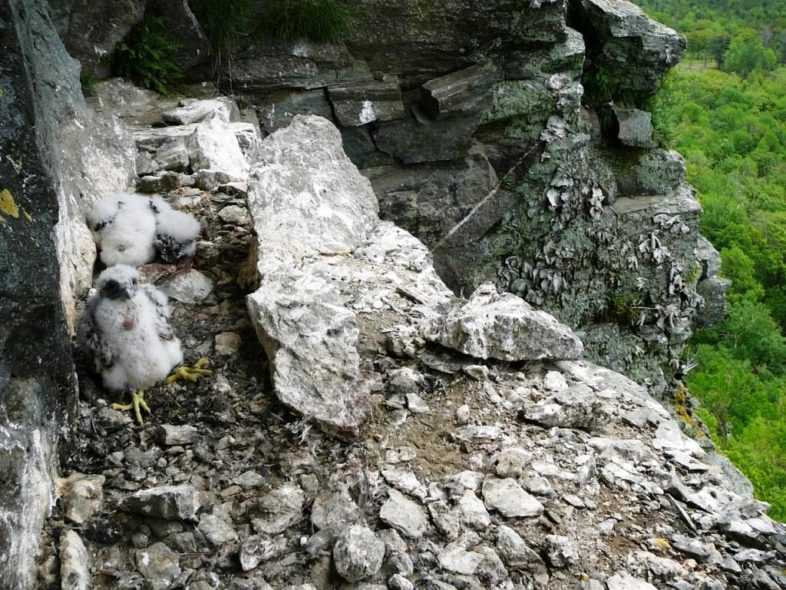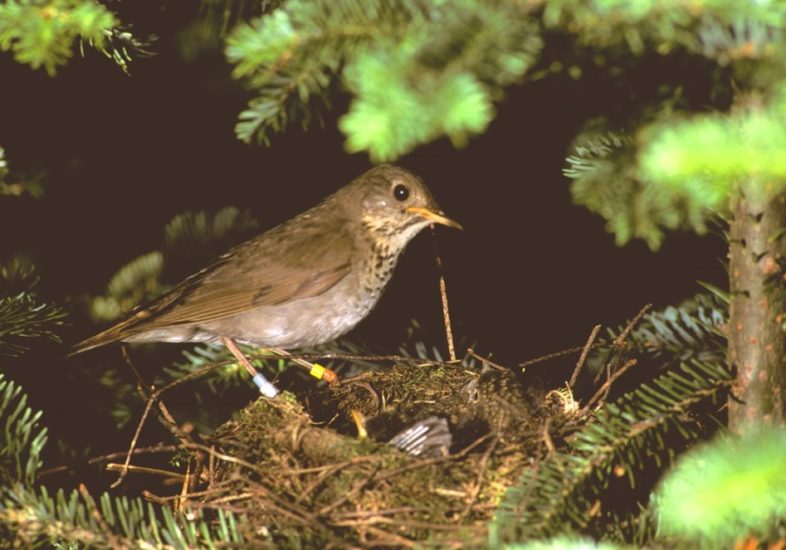It’s extremely rare that banded birds are recovered or re-sighted outside of the immediate area in which they were banded. This is especially true for songbirds, since in order to decipher the numeric combination on their tiny leg bands, they must be examined in hand. With that in mind, it’s exciting to note that we recently received two “foreign recovery” reports of VCE-banded birds.
Peregrine Falcon 47/X

This banded Peregrine Falcon was photographed in Nov. 2017 feeding on prey in Orwell, VT. The alpha-numeric color band on its left leg was easily deciphered as “47/X”, confirming that it was a male, banded as a nestling in 2006 at Bird Mt. in Ira, VT. Photo by Renee Arbib Traverse
On November 20 of this fall, Renee Arbib Traverse of Sudbury, VT was driving with her husband Russ along Route 73 in nearby Orwell when she saw a Peregrine Falcon with prey perched on a power pole. They pulled over, and Renee was fortunate to get several good photos of the bird from her car window. Later, she posted one on the Vermont Birding Facebook page, noting that “both legs were banded and they were visible in the photo.” VCE’s Steve Faccio, who banded 154 Peregrine chicks in Vermont between 1998 and 2006, saw the post and was able to confirm that the color band “47/X” was a match for a male nestling he banded at Bird Mt. in Ira, VT on 5 June 2006! Steve replied to Renee on Facebook, and posted a photo he took of the chick on the nest ledge sporting his new “hardware.”

At roughly 23-days old, 47/X displays a defiant personality, along with new bands applied on 5 June 2006. His female sibling can be seen on the nest ledge in the background. Photo by Steve Faccio
Normally, that’s where the story would end. But as it turns out, there was a closer connection between these two events, as Renee’s husband Russ grew up on a farm near the base of Bird Mt., a place which the couple visits frequently! And while the spot where Renee photographed 47/X is just 15 miles from the cliff where the bird hatched, it seems likely that he is part of a nesting pair somewhere in the southern Champlain Valley, which supports a number of active nest sites.

A view of both young Peregrine Falcon chicks on their nest ledge at Bird Mt. in Ira, VT. Photo by Steve Faccio
At 11 years old, 47/X has not set any longevity records for Peregrines, although he has enjoyed a longer-than-average life-span for these “elite athletes” of the bird world, where even small, age-related declines in flight performance, eyesight, or timing can have major consequences for survival. Indeed, in a paper published in the Journal of Raptor Research, Faccio and his co-authors analyzed 238 recoveries of 986 Peregrines banded as nestlings in New England from 1990-2009, and found that a leading cause of death was colliding with stationary objects, often while in pursuit of prey.
Bicknell’s Thrush 2341-24320

A banded Bicknell’s Thrush at the nest, Stratton, Mt., VT. Photo by Steve Faccio
Among the 1,790 Bicknell’s Thrushes that Chris Rimmer, Kent McFarland and many others at VCE have banded over the past 26 years, from Vermont’s Mt. Mansfield to Haiti’s Pic La Visite, none had ever been recaptured or recovered by anyone else. That changed this past 19 May, when Randy Merchant from Gilsum, NH found a freshly-killed migrant that had struck a window on his barn.
Although Randy had never before encountered a banded bird, he was astute enough to know that his find merited reporting. He carefully recorded the band number—2341-24320—and reported it to the US Geological Survey Bird Banding Lab (BBL) in Patuxent, MD. With a record of the band in its archives, the BBL reported the recovery to its original bander—VCE. Needless to say, we experienced mixed emotions at receiving the news: dismay at the bird’s unfortunate demise, but genuine excitement at unraveling a small piece of the Bicknell’s Thrush migratory puzzle.
Here’s what we learned: Bicknell’s Thrush #2341-24320 first became known to VCE when John Lloyd banded it as a hatching-year bird on Mt. Mansfield on 16 September 2015. True to the species’ tendency for site fidelity, the bird returned from its Caribbean overwinter sojourn to Mansfield in 2016, when we recaptured it as a known male in breeding condition on 29 June, then again on 6 July, and for a final time that season on 14 September! Following another southward migration that would have found the bird overwintering on Hispaniola, Cuba, Jamaica, or Puerto Rico, 2341-24320 was only 109 miles from his final destination on Mansfield when he struck Randy’s barn window. It’s entirely possible that he would have arrived back on Mansfield for a third consecutive summer after just one more night’s migration. So close, and yet so far…

Most excellent to read this, but wish it hadn’t ended badly for the Bicknell’s. Keep up the great work, VCE team!